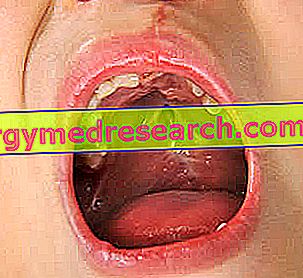Definition
Actinic keratosis (or solar keratosis) is a skin lesion derived from prolonged and excessive exposure to the sun and UV rays, which leads to the formation of skin rash and erythematous scales on the skin. More specifically, this pathology appears after years of repeated solar exposures; not surprisingly, actinic keratosis mainly affects the elderly.
Causes
Excessive and frequent exposure to sunlight or ultraviolet rays in general (eg artificial tanning) can cause skin disorders such as actinic keratosis; solar keratoses represent a cumulative phenomenon, in the sense that the skin, after having absorbed UV radiation for years, suddenly rebels, forming more or less evident sores.
Symptoms
Actinic keratosis affects rather sensitive skin areas, such as the face, hands, neck and scalp. In the sites affected by actinic keratosis, a clinical picture manifests itself characterized by erythematous scales of natural / yellowish or gray color, often surrounded by a red halo and telangiectasias. Itching may also occur, wart-like lesions and skin xerosis.
- Actinic keratosis is one of the pre-neoplastic forms: it is not a tumor, but the possibility that the lesion turns into a malignant form is still real
Solar radiation accelerates skin photoaging: in addition to actinic keratosis, the skin responds with wrinkles, freckles and solar freckles.
Information on Actinic Keratosis - Drugs for the Treatment of Actinic Keratosis is not intended to replace the direct relationship between health professional and patient. Always consult your doctor and / or specialist before taking Actinic Keratosis - Drugs for the treatment of Actinic Keratosis.
drugs
Since actinic keratosis is considered a pre-cancerous form, it is recommended to consult the doctor from the first symptoms, in addition to the periodic check-up to monitor the progression of the disease. Despite what has been said, it is right to reassure: it is not certain that the manifestation of the keratotic lesion always degenerates into a tumoral form, but the possibility, albeit minimal, must be considered.
The treatments recommended to treat actinic keratoses are many:
- photodynamic therapy: aimed at eliminating cancerous and precancerous forms from the skin.
- cryotherapy with liquid nitrogen
- laser therapy
- pharmacological therapy
It is common knowledge that "prevention is better than cure": according to this, it is understandable that it is essential to protect the skin from the UV radiation of the sun and artificial lamps, always applying a cream with sun filters before exposing oneself to the sun. For the bald, it is essential to wear a hat: apparently banal, but very useful to protect the scalp from solar radiation.
Let's analyze, now, in more detail, which drugs are used in therapy for the treatment of actinic keratosis; the therapy is purely local.
- Diclofenac (eg. Itamidol, Dicloreum, Zeroflog Spray Mucosa, Dolaut 4% U.EST.GEL SPR.25G): the drug belongs to the NSAID class. A gel formulated with diclofenac is very effective to counteract the lesions generated by actinic keratosis; to underline, however, that the treatment times are rather long. It is recommended to apply a film of cream directly on the lesion affected by actinic keratosis, once a day for 2-3 months. Do not exceed 8 grams per day. Generally, the first benefits are evident after 30 days.
- Diclofenac 3% gel in hyaluronic acid (eg Solaraze): the combination of the two drugs is indicated for the dual analgesic-antioxidant action: actinic keratosis can generate pain and cutaneous damage, therefore diclofenac is particularly useful; moreover, given that the cause of the skin disorder resides in exposure to UV rays, a product with antioxidant activity such as hyaluronic acid is very useful. Furthermore, hyaluronic acid enhances the action of diclofenac. Apply the product on the skin affected by actinic keratosis, taking care to massage to favor absorption. Continue therapy for 2-3 months, or until complete remission of symptoms. Do not exceed 8 grams per day.
- Fluorouracil (eg Fluorouracil TEVA): it is a chemotherapy drug belonging to the class of antimetabolites. The drug is used in therapy for the treatment of actinic keratosis because it is able to destroy damaged cells, blocking their functionality. The product is no longer marketed in Italy for the treatment of actinic keratosis. In countries where it is authorized, the dose involves applying the product on the skin 1-2 times a day, possibly covering the skin with an occlusive bandage. The duration of therapy is 3-4 weeks.
- Imiquimod (eg. Aldara cream): the drug is formulated in the form of a topically applied cream, indicated to treat actinic keratosis: the drug exerts its therapeutic activity by acting as an immunomodulator, inhibiting the replication of cells damaged by actinic keratosis and potentially malignant. Indicatively, it is recommended to apply the product (cream or gel) 3 times a week for a month. After this time, continue with 4 weeks of suspension, at the end of which it is possible to repeat the treatment in case of persistence or relapse. Consult your doctor.
- 5-aminolevulinic acid (eg Gliolan): the drug is formulated in the form of a cream for the treatment of actinic keratoses not associated with hyperkeratosis of the scalp and face. Indicated as a second-line therapy, to be used when the other active ingredients are not able to bring obvious benefits to the patient.
- Collagenase (eg. Nuroxol, Iruxol): apply the cream on the area affected by actinic keratosis, once a day. The duration of therapy should be determined by the doctor. The enzymes called collagenases are involved in the complex activity of destruction of the extracellular structures involved in pathological processes: for this reason, collagenase-based drugs are sometimes used to treat actinic keratosis.



